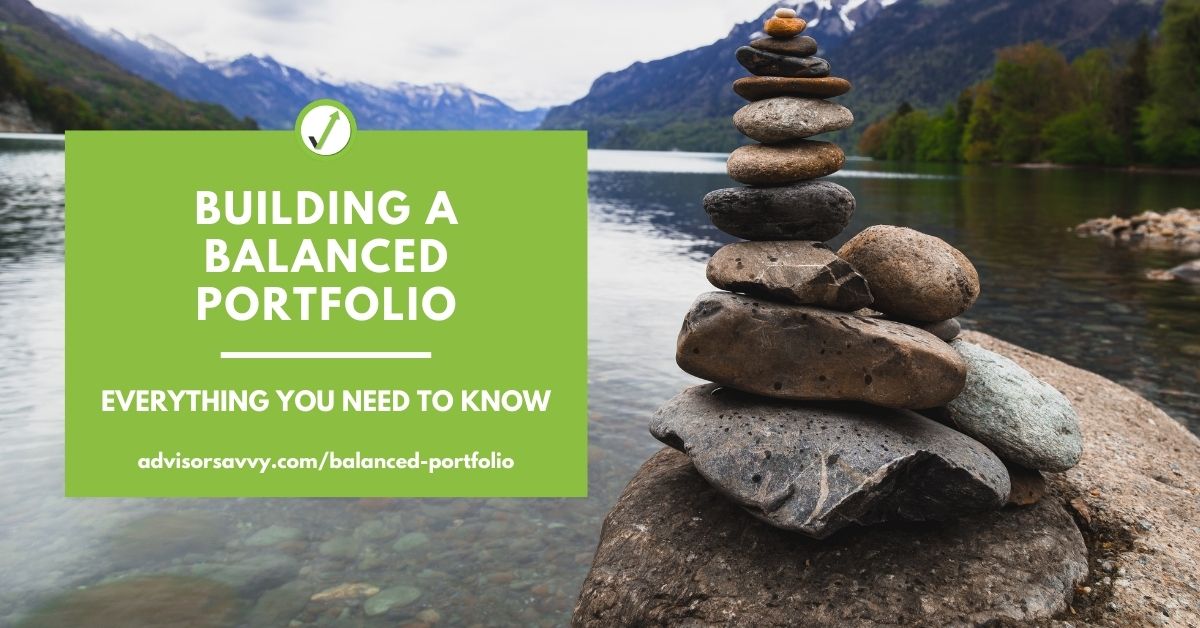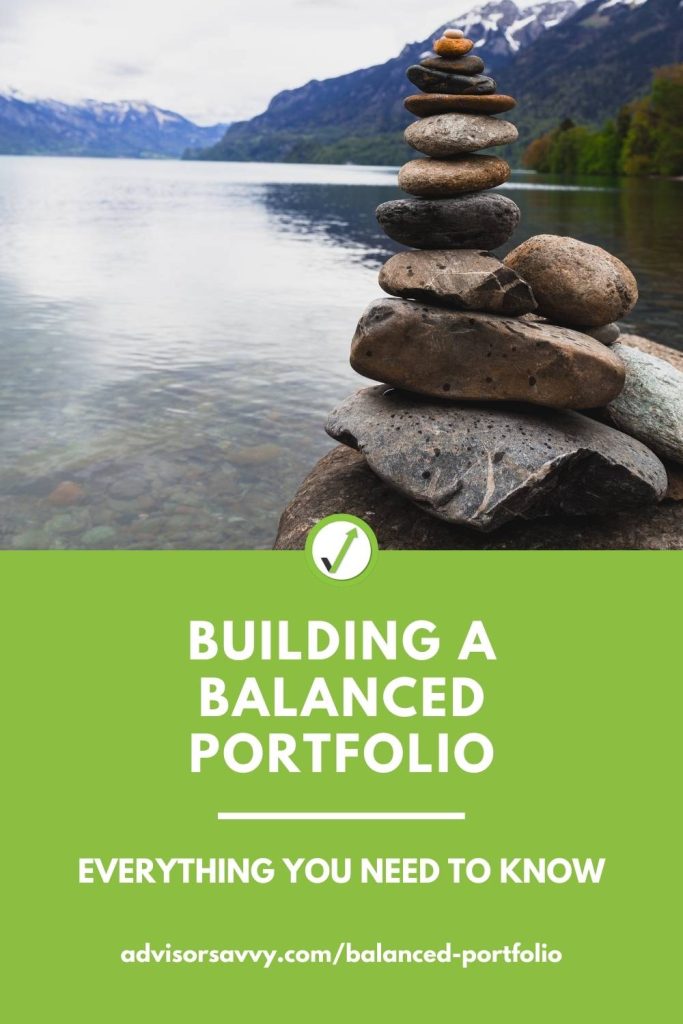
The last few years have been a wild ride for investors trying to second-guess market trends. Adding to the uncertainty have been the ups and downs of the global COVID-19 pandemic response on a political level. It’s no wonder that many people are asking themselves how to build a balanced portfolio. Let’s take a look at everything you need to know for creating a balanced portfolio that can chart a course through challenging times.

Table of contents
- What is a balanced portfolio asset allocation?
- What does a balanced portfolio look like?
- Why is a balanced portfolio important?
- What is the average return on a balanced portfolio?
- When should you be in a balanced portfolio?
- Does risk tolerance change over time?
- Why is it important to rebalance portfolios?
- Examples of balanced portfolios in Canada
- Building a Balanced Portfolio
What is a balanced portfolio asset allocation?
A balanced portfolio is typically a mix of stocks and bonds within your investment holdings. The strategy is to take advantage of stock market growth with a cushion in bonds to mitigate downturns. Stocks tend to be the engine driving portfolio growth. Bonds provide stability to effectively balance your investments.
Typically, a balanced portfolio has a 50/50 or 60/40 split between stocks and bonds. And because you have a mix of stocks and bonds, you are balancing your risk level — and your possible return on investments.
Having a balanced portfolio means striking a balance between preserving your capital and achieving growth. Balanced portfolio asset allocation suits investors with moderate risk tolerance.

Match to your perfect advisor now.
Getting started is easy, fast and free.
What does a balanced portfolio look like?
The even split between stocks and bonds is something that a balanced portfolio strives for on an ongoing basis.
Another aspect of building a balanced portfolio is the geographic allocation of investments. That means holding a mix of Canadian, US, and international holdings. With better-performing US stocks over the past few years, portfolio managers have often reallocated profits to Canadian stocks to create more geographic balance.
Balanced portfolios essentially provide room for growth but may miss at the top end of upturns. At the same time, however, bonds will save the day in times of drastic downturns. So a balanced portfolio looks like a sustainable mix of investments that should appreciate over time.
Related Reading: How To Invest In Index Funds In Canada
Why is a balanced portfolio important?
Slow and steady may indeed win the race when it comes to your investments. That makes a balanced portfolio important to consider for your financial success. According to FinancialSamurai.com here are some of the comparative results:
- A 10-year bond yield provides a risk-free rate of return
- A relatively balanced portfolio of 60% stocks and 40% bonds has netted returns of 8.3% since 1926
- A 100% stock portfolio has achieved returns of 10.2% since 1926
- A 100% bond portfolio has returned 5.4% since 1926.
A low-risk investor would look favourably at the safe returns of bond investments, while a moderate-risk investor would likely feel more comfortable with a balanced portfolio at a solid return rate of 8.3%. Meanwhile, high-risk investors may have greater stress overall but achieve even higher gains.
What is not reflected in these numbers, however, are the distressing dips that occur from time to time that could throw any investor off their game. If we look at the 2008-2009 market sell-off, many investors sold at the bottom of the market. That eroded their holdings and, for some investors, it took a decade to make up the losses.
It’s interesting to note that when looking at a portfolio completely invested in stocks, out of 91 years there have been 25 years of losses. The worst year saw portfolio valuations drop by 43%.
What is the average return on a balanced portfolio?
Statistics compiled by FinancialSamurai.com show the following rates of return, consistent with other sources:
- Investing 40% in stocks and 60% in bonds historically provides an average annual return of 7.8%.
- 50% in stocks and 50% in bonds has provided an average annual return rate of 8.3%.
- A 60% stock to 40% bond allocation typically produces an 8.7% return rate.
With particular attention to retirees, it’s advisable to have no more than 60% of funds in stocks. Given an average annual return rate of 8.7% based on a 60/40 stock/bond allocation, that equates to approximately 4X the rate of inflation and 3X the risk-free rate of return. However, older investors need to be in tune with their ability to tolerate market churn.
Balance-focused investors want to reduce volatility by having income-generating investments in their portfolio. They recognize that there could be moderate growth in their holdings. At the same time, they are willing to tolerate some ups and downs in the short term because clearly, stock market performance is not guaranteed.
When should you be in a balanced portfolio?
There are no hard and fast rules as to the type of investments each individual should choose. There are, however, typical situations when balanced portfolios are a good option. Bear in mind that you may not achieve the highest returns as markets tick upward. That said, as mentioned above, you may also avoid losses in market downturns because of a balanced portfolio allocation.
Consider a balanced portfolio if your situation is like any of these:
- You’re not experienced in investing and want a good compromise between achieving long-term goals while avoiding high risk.
- As a retiree, you feel comfortable with accepting variances in your account based on market performance.
- You are in a younger age category with goals like as buying a home or saving for a major vacation 5 to 10 years down the road.
- Your investment runway is long (10 years+) but you don’t want to weather big fluctuations in your account over time.
Does risk tolerance change over time?
For new investors at any age, the fear of losing equity may drive panic selling at low points rather than staying the course. And those who have a high-risk tolerance may surf the investment waves trying to make a quick profit.
Those with a lengthy investment horizon might be able to stomach the market retractions compared to retirees. Young investors who are earning income and have a longer investment timeline have more leeway to take risks. A balanced portfolio may seem too staid for young people who might prefer to have a larger allocation in stocks. However, as people move into stages of life with more consideration for wealth accumulation and retirement, tolerance for risk drops accordingly.
Why is it important to rebalance portfolios?
Even if you start with a 50/50 split between stocks and bonds, your portfolio may become weighted in favour of one or the other over time. If there’s a big uptick in stock performance you might then have 80% of your holdings in stocks versus 20% in bonds. Your risk level has inadvertently drifted upward and needs attention.
To maintain a medium risk level, you or your portfolio manager will want to reallocate gains. That means taking the proceeds from selling successful stocks to purchase more bonds and even out the portfolio, ensuring the portfolio is rebalanced on an ongoing basis.
This approach echoes the expression of ‘buying low and selling high’. You’re selling assets that have done very well and put the profits into a less risky haven. As we saw with the statistics above, stocks tend to outperform bonds over time. So typically, rebalancing means you are selling stocks and buying more bonds.
Examples of balanced portfolios in Canada
There are many options available to investors for balanced portfolios in Canada. That’s because most if not all of the big financial providers have medium-risk, balanced portfolio offerings. Examples of these include:
TD Comfort Portfolios are made up of a collection of TD Mutual Funds that are selected to offer a mix of asset classes, sectors, and geographies for specific risk tolerances and time horizons.
This fund offers a balance of 60% stocks (Canadian, US, and international) and 40% bonds (Canadian). As a result, you’ll have stability while also seeing strong potential for growth.
The fund invests primarily in a broadly diversified portfolio of mutual funds. Emphasis is on fixed-income securities and Canadian, US, and international equity securities.
This is a multi-asset global solution with a neutral mix of 60% equities and 40% fixed income. The fund employs active asset allocation across multiple dimensions of the portfolio to take advantage of market opportunities and mitigate risk.
The portfolio attempts to create a diversified portfolio by allocating its investments across a balanced blend of asset classes. Within the asset classes, the portfolio invests primarily in mutual funds including savings, income and growth funds.
This low-to-medium risk portfolio mainly invests in global equities to help provide growth, along with some fixed income — 30% to 50% fixed income and 50% to 70% equity.
Building a Balanced Portfolio
In today’s world, you can choose to self-manage your funds, work directly with a bank or other financial institution, or work with an advisor who can manage the day-to-day investment strategy. The first thing you’ll want to consider is your experience and comfort level with investing. It’s also important to know and compare fund management fees. Taking the time to research is important!
As a result, choosing the right management solution is key. If you have expectations of appreciable short-term growth, you could be disappointed with an investment strategy focused solely on protecting your current wealth. Watching funds stagnate while the market grows will fall short of your expectations. On the other hand, if you are cautious and choose a high-risk solution that will cause stress. Advisorsavvy can help you find a suitable advisor in your area if you a struggling with the next steps.
Everything you need to know to build a balanced portfolio includes:
- Being honest about your risk tolerance level and communicate that to your advisor.
- Taking into consideration your investment timeline based on your income situation and stage of life.
- Choosing the right investment option: self-managed funds, direct with a financial institution, or working with an advisor.
- Comparing management fees which can affect profits.
- Staying apprised of your investment outcomes over time.

